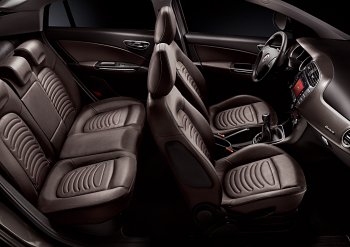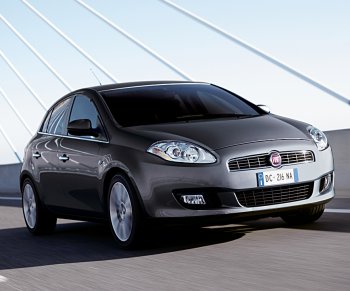|
Beauty as the
most up-to-date expression of Italian style
|
|
Developed by the
Fiat Style Centre, the design of the Bravo is a perfect
blend of aggressiveness and power, as you would expect of a
5-door compact, set off by an extraordinary amount of
roominess inside. A sporty, flowing line that guarantees
robustness and agility in spite of its aesthetic refinement.
To start with,
the new model is generously sized – 434 centimetres long,
179 cm wide, 149 cm high and with a wheelbase of 260 cm –
even if the Bravo’s smooth, almost aggressive lines give it
a sporty, sparkling and extremely dynamic look, designed to
underline its ‘muscles’ simply and straightforwardly. The
Fiat Bravo’s strong personality is particularly evident at
the front; the front end is important, like that of a small
GT, into which the elongated headlights are set with
original tension and strong Italian styling (they are the
work of Magneti Marelli - Automotive Lighting).
The externals a
succession of classical references, an excellent opportunity
to re-read the brand’s traditional styling elements in a
modern key. Take a quick look. First, the original rear
light clusters which recall those of the previous Bravo,
which were also the work of Magneti Marelli - Automotive
Lighting. The front reiterates the distinctive features of
recent Fiat models, particularly the Grande Punto: from the
raked, forward windscreen to the drop-shaped headlights,
inspired by the well-known Italian GT tradition, down to the
graphics of the lower air intake and the grille. The
tapering of the front and rear underline the impression of
great compactness conveyed by the Fiat Bravo. But this in no
way diminishes the elegance of the lines that run smoothly
from front to back, into the integral bumpers and the light
clusters with their converging wedge shape. Suffice it to
say that in the rear of the car, the waistline is high and
slopes sharply, to emphasise the sense of sportiness.
The styling of
the Bravo reconciles stylistic elements that were once
irreconcilable. For example, a front end that is aggressive
but modelled to respect pedestrian safety requirements. Both
the structure and the modelling are the fruit of detailed
analysis, developed in line with the latest legislation,
which envisages rounder shapes, a wider bonnet and a tapered
bumper structure, which is easily perceptible in the plan
view, to reduce the area involved in a collision to a
minimum.
And if the Fiat
Bravo conveys a new concept of sportiness on the outside,
the inside environment is one of superb quality and
painstaking attention to detail, giving a sensation of great
solidity and compactness. The design, materials and fabrics
used are all enhanced by the carefully chosen colour
combinations, which underline the elegance or sportiness of
the different versions. The Active outfit offers 2 interior
environments, the Dynamic and Emotion versions offer a
choice of 3 environments with 3 different shades, and the
Sport outfit proposes 2 environments in 2 different colours.
Bravo customers are also offered leather upholstery: on the
Dynamic and Elegance versions, this comes in black with grey
or blue stitching, or in marmoset with contrasting
stitching. The Sport outfit offers black leather upholstery
with red or blue overstitching.
The front and
rear seats of the Bravo deserve a special mention. They were
designed to guarantee the best possible comfort to all
passenger percentiles, and developed in close collaboration
with the best Italian ergonomics and sports medicine
specialists. First of all, to enhance comfort and to absorb
vibration in particular, the front seats incorporate an
improved lumbar support system that sustains the back
better. The front seats are also padded with foam that
adapts to the shape of the body and have an 'antisubmarining'
structure that prevents the body from sliding forward, under
the seat-belt, in the event of a violent head-on impact. The
front seats also offer various adjustments: height,
longitudinal (with a stroke of an amazing 240 mm), squab
rake (by a knob that provides continuous step adjustment),
and lumbar. The height of the head-restraints can be
adjusted and, on request, they can be fitted with an
anti-whiplash system, which brings the restraint closer to
the occupant’s neck in the event of a collision. And
finally, the front seats offer the option of electric
movement and adjustment, with intuitive, ergonomic controls.
The rear seat squab splits 40/60, and the seats incorporate
an antisubmarining structure and padding with differentiated
support in different parts of the seat cushion (this is a
parameter that measures the compression of the padding under
the weight of the body). The rear seats are also fitted with
Isofix attachments for child seats, and three
head-restraints.
Great care has gone into the design of the instrument panel
(developed by Magneti Marelli), which is enclosed in a
dashboard that is turned entirely towards the driver, with
soft lines that blend aesthetically with the lines of the
facia. The large, immediately visible digits of the
instrument graphics make the information easy to read and
readily available. At night the illumination is orange, a
shade that allows the pupil to focus more rapidly when
alternating between the dark of the road outside and the
luminosity of the dashboard. The onboard instrumentation is
available in two versions, depending on the outfit, and
includes a number of important functions. For example, the
multi-function display gives access to several menus, and
sub-menus. These speak the driver’s language (there is a
choice of Italian, English, German, Portuguese, Spanish,
French, Dutch, Polish and Turkish), and offer a wide range
of functions, including the time, date, programmable
acoustic signal, radio visualisation, check control and more
besides.
|
 |
|
 |
|
There is also a trip computer, of course, which provides a
data set regarding the previous journeys made, and the
current journey.
Class-beating ergonomics and
roominess
The Fiat Bravo is friendly and practical, with an unbeatable
amount of living space and passenger room, that is hinted at
by the exterior dimensions. The new model promises
comfortable journeys, and the enjoyment of tangible,
all-enveloping well-being on board. The engineers have
achieved this goal by adopting the latest ergonomic criteria
from the earliest stages of the development of the Fiat
Bravo to define the parameters that measure a car’s capacity
to respond to the demand for well-being and comfort on
board. As a result, the Bravo achieves excellent values for
the essential ergonomic functions: space and interior
volume, roominess, access, visibility, loading capacity and
user-friendliness.
These
characteristics have always been winning qualities, and
today they are even more important, because we spend more
time in our cars, we are becoming more accustomed to cars
from higher segments, which are therefore roomier, and the
average height of the population is increasing. This is
another reason why the Bravo achieves excellent results in
terms of transverse roominess at shoulder height, in the
front and rear, with values that are outstanding for segment
C, in all fields: from roominess to access, visibility and
ease of use. This means being able to get in and out of the
car easily and comfortably, and finding yourself in a
comfortable, protective environment once you are seated.
The interior
space in the Fiat Bravo is the result of a good balance
between the volumes of the passenger compartment, even
though, from the outside, the car is clearly compact and
dynamic. The parameters that define the posture, the
position of the driving seat and of the passenger seats in
the many possible configurations, the overall roominess and
the interior volume have all been optimised. The end result
puts the Bravo firmly at the top of its class in this
context. For example, the combination of a driver’s seat
that adjusts for height and a steering wheel that adjusts
for height and reach, produces excellent values of roominess
as well as a perfect driving position for drivers of all
heights (from 1.50 to about 2 metres). Even if the driver
himself is tall, there is still room for an equally tall
passenger to sit comfortably behind him; it is the only car
in its segment that can accommodate 184 cm tall passengers
comfortably on the rear seat when those in the front seat
are in the 90 percentile, in other words 183 cm tall. And
this does not detract from the luggage capacity which is 400
litres in the normal configurations, and 1175 litres with
the rear seats folded down.
Driving is made
particularly enjoyable by the position of the pedals, the
steering wheel alignment, the position of the armrest and
footrest, the excellent manoeuvring of the gearshift and the
perfect visibility of the instrumentation and the main
controls. This sensation of enjoyment is heightened by the
excellent profiling of the wrapround seats that support the
body even in more dynamic driving situations. And the
adoption of the latest virtual ergonomic structuring
techniques on the Fiat Bravo ensures that all the onboard
instrumentation and primary controls are extremely
user-friendly; all the controls are within easy reach,
perfectly visible and easy to use. The interior is one of
the most practical in its category, with a useful storage
unit under the passenger seat, pockets in the doors, a
centre console with space for bottles, documents, maps and
coins, storage compartments on the facia for keys,
eyeglasses and remote controls, and a large glove
compartment in front of the passenger.
A new logo for the Fiat
brand
A new logo, which underlines the new strategy that has been
implemented by the brand in recent months, now debuts on the
front of the new Bravo, and will gradually be adopted on all
Fiat models. In this dynamic context, there has been a
constant succession of new products (from the Croma to the
Grande Punto, the Panda, the Fiat Sedici and now the Bravo),
and a tangible sign was needed to symbolise the turnaround
that is driving Fiat towards new challenges.
Created jointly
by RobilantAssociati (an agency specialising in Brand
Advisors & Strategic Design) and the Fiat Style Centre, the
new symbol is derived from the famous shield that decorated
the front of Fiat cars from 1931 to 1968, with the
vertically elongated letters of the word 'FIAT' standing out
against a ruby red background, encased in a chromed round
frame. It has a three-dimensional effect which conveys an
idea of technology, Italian design, dynamism and a strong
personality, while it also harks back to the round logo
(white wording against a red background, surrounded by
laurel leaves) that identified powerful, high performance
Fiat models for many years.
The essential,
strong new logo therefore conveys 'change in continuity', a
sign of the past re-read in a modern key which is
particularly representative of Fiat today, a brand with its
sights on the challenges of the future but also proud of its
historical identity. The two main elements of the new logo
(the shield shape and the red colour) immediately bring to
mind the Fiat 524 of 1931, which was the first to sport a
rectangular logo that blended into the new grille, designed
with stylistic but also aerodynamic pretensions, in the
shape of a shield with vertical elements. The new Fiat logo
sums up the mission of an Italian company that for over one
hundred years has been building cars with beautiful styling,
that are accessible and capable of guaranteeing a better
quality of everyday life. |
|